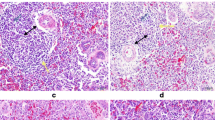Abstract
This communication reports about heat shock protein response after arsenic exposure in broiler chickens in vivo and in vitro both. Splenocytes harvested in presence of sodium arsenite expressed Heat shock protein 70 (HSP 70) which could be identified on the basis of relative migration pattern and western blot analysis. Serum levels of HSP 70 in broiler chicken also increased after continuous feeding of sodium arsenite in drinking water. This particular observation may be attributed towards systematic inflammation, oxidative stress and hepatocellular injury. In vitro relative quantification of transcription level of HSP 70 revealed that splenocytes harvested in presence of sodium arsenite expressed (final concentration 3 and 7 μM/ml) more HSP 70 in comparison to cells harvested without sodium arsenite and the values were statistically significant (P < 0.001) when compared to untreated control. Collectively this result indicated that, HSP 70 level increased both in vivo and in vitro trials and may be used as potential molecular and toxicological biomarker.






Similar content being viewed by others
References
Desesso JM (2001) Teratogen update: inorganic arsenic. Teratology 63:170–173
ATSDR (Agency for Toxic Substances and Disease Registry) (2007) Toxicological profile for arsenic (Update). Available on http://www.atsdr.cdc.gov/toxprofiles/tp2.html. Accessed 2 Sept 2009
Del Razo LM, Quintanilla-Vega B, Brambila-Colombres E, Calderón-Aranda ES, Manno M, Albores A (2001) Stress proteins induced by arsenic. Toxicol Appl Pharmacol 177(2):132–148
Feder ME, Hofmann GE (1999) Heat-shock proteins, molecular chaperones, and the stress response: evolutionary and ecological physiology. Annu Rev Physiol 61:243–282
Li GC, Nussenzweig A (1996) Thermotolerance and heat shock proteins: possible involvement of Ku autoantigen in regulating Hsp70 expression. EXS 77:425–449
De Pomerai D (1996) Heat-shock proteins as biomarkers of pollution. Hum Exp Toxicol 15(4):279–285
Sanders BM (1993) Stress proteins in aquatic organisms: an environmental perspective. Crit Rev Toxicol 23(1):49–75
Sanders BM, Dyer SD (1994) Cellular stress response. Environ Toxicol Chem 13:1209–1210
Ryan JA, Hightower LE (1996) Stress proteins as molecular biomarkers for environmental toxicology. EXS 77:411–424
Sanders BM, Martin LS (1993) Stress proteins as biomarkers of contaminant exposure in archived environmental samples. Sci Total Environ 139–140:459–470
Chen HL, Li DF, Chang BY, Gong LM, Dai JG, Yi GF (2002) Effects of Chinese herbal polysaccharides on the immunity and growth performance of young broilers. Poult Sci 82(3):364–370
Beetham PK, Glick B, Dick JW (1993) A comparison of three isolation methods for obtaining immunoglobulin A from turkey bile. Avian Dis 37(4):1026–1031
Towbin H, Staehelin T, Gordon J (1979) Electrophoretic transfer of proteins from polyacrylamide gels to nitrocellulose sheets: procedure and some applications. Proc Natl Acad Sci USA 76(9):4350–4354
Doyle JJ, Spaulding JE (1978) Toxic and essential trace elements in meat—a review. J Anim Sci 47(2):398–419
Currie S, Tufts B (1997) Synthesis of stress protein 70 (Hsp70) in rainbow trout (Oncorhynchus mykiss) red blood cells. J Exp Biol 200(Pt 3):607–614
Werner I, Nagel R (1997) Stress protein hsp60 and hsp 70 in three species of amphipods exposed to cadmium, diazinon, dieldrin and fluoranthene. Environ Toxicol Chem 16:2393–2403
Heimbach JK, Reznikov LL, Calkins CM, Robinson TN, Dinarello CA, Harken AH, Meng X (2001) TNF receptor I is required for induction of macrophage heat shock protein 70. Am J Physiol Cell Physiol 281(1):C241–C247
Lewis S, Handy RD, Cordi B, Billinghurst Z, Depledge MH (1999) Stress protein (HSP) methods of detection and their use as an environmental biomarker. Ecotoxicology 8:351–368
Molvarec A, Rigó J Jr, Lázár L, Balogh K, Makó V, Cervenak L, Mézes M, Prohászka Z (2009) Increased serum heat-shock protein 70 levels reflect systemic inflammation, oxidative stress and hepatocellular injury in preeclampsia. Cell Stress Chaperones 14(2):151–159
Wright BH, Corton JM, El-Nahas AM, Wood RF, Pockley AG (2000) Elevated levels of circulating heat shock protein 70 (Hsp70) in peripheral and renal vascular disease. Heart Vessels 15(1):18–22
Author information
Authors and Affiliations
Corresponding author
Rights and permissions
About this article
Cite this article
Das, S., Pan, D., Bera, A.K. et al. Stress inducible heat shock protein 70: a potent molecular and toxicological signature in arsenic exposed broiler chickens. Mol Biol Rep 37, 3151–3155 (2010). https://doi.org/10.1007/s11033-009-9894-7
Received:
Accepted:
Published:
Issue Date:
DOI: https://doi.org/10.1007/s11033-009-9894-7




